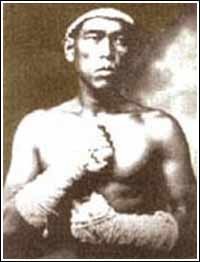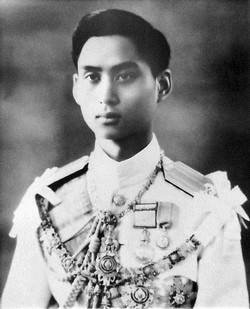|
History of Thailand
"Land of Smiles turning into Land of Chaos?"
"History of Thailand" was last updated on April 13, 2012
The history of Thailand is rich, complicated and hosts bloody wars, massacres, military coups and corruption.
Welcome to Thailand!
First some interesting facts
Did you know that...
- Thailand was the only Southeast Asian country that didn't turned into a colony,
unlike its neighbouring countries Laos, Cambodia and Burma.
- I've read the history of Thailand and was just amazed by the fact
that the country has been through 19 military coups from 1932-2006! That's just chaos!
- King Bhumibol, the current king of Thailand, has been the longest reigning current monarch worldwide.
- Thailand was known by the name, Siam until 1939.
History doesn't necessarily need to be boring. When I read the history of Thailand, I found some interesting parts:
cultural, military, political and social aspects.
So, I have divided the history into a timeline -- focusing on the main events which formed the country of Thailand.
Let's get started!
Early Thai History
Before Christ (BC): 2nd or 3rd Century
 The history of Thailand - The Mon People - Image credit: wikipedia.org
The history of Thailand - The Mon People - Image credit: wikipedia.org
|
- The exciting Theravada Buddhism is introduced to the region by Indian Missionaries.
It is said that the first group known to be impacted
by Buddhism was the Mon people, originally from Burma.
From the Mon, Buddism spread to other ethnic groups in the region, including the Thais.
After Christ (AC): 6th Century
- The Theravada Buddhist Dvaravati civilization occupies Northern Thailand.
The people of Dvaravati used the ancient Mon language, but whether they were ethnically Mon is unknown.
8th Century
9th Century
- The Khmer Empire, based at Angkor,
conquers Thailand. Lopburi becomes the Khmer's headquarter in present Thailand.
But in the 13th century - The Khmer domination is weakened from various reasons: bad economy, conflicts, malaria,
plague and other diseases.
1238
 History of Thailand - Sukhotai -
History of Thailand - Sukhotai -
Image credit: travel.webshots.com
- The Thais in the upper Chao Phraya Valley capture a Khmer outpost at Sukhotai. They establish a Siam kingdom at Sukhotai.
1278-99 - The History of Thailand begins?
- The reign of King Ramkhamhaeng.
He seizes control of much of the Chao Phraya Valley and establishes the capital of the first kingdom of Siam at Sukhotai.
Sukhothai is
considered by most Thai historians to be the first true Thai kingdom.
This is what King Ramkhamhaeng did for his country...
- The Theravada Buddhism becomes state religion.
- In 1283, King Ramkhamhaeng
invents
Thai written language.
- King Ramkhamhaeng was also building Angkor-inspired temples that defined Thai art.
When he died in 1299, his empire declined.
Return to top
1351-1369
 History of Thailand - Ayutthaya
History of Thailand - Ayutthaya
1529-1785
17th Century
- Ayutthaya makes a comeback with foreign trade - first with Portugal, then Spain, England and Holland.
1767
 History of Thailand - Muay Thai founder: Nai Kanom Tom -
History of Thailand - Muay Thai founder: Nai Kanom Tom -
Image credit: thaiboxingguide.com
|
- Ayutthaya is recaptured by the Burmese, who burns it to the ground.
The Burmese takes tens of thousands of prisoners and abandon the city to the jungle.
Here's something interesting which I picked up for you...
- The legendary Muay Thai boxer, Nai Kanom Tom was one of the prisoners.
Boxing matches between Thai prisoners and Burmese
fighters were arranged, and Nai Kanom Tom was included in the group of Thai boxers. He defeated the Burmese boxers in a short time.
The Burmese monarch then offered him his freedom if he could fight
9 other Burmese champions. And so he did.
The Burmese monarch was
impressed, he was freed and went back to Ayutthaya.
Today, his great victory is still well recognized by the Thai people.
"National Muay Thai Day" is entitled on March 17 to honor
Nai Kanom Tom. He is regarded as one of the great founders of Muay Thai.
Wow... I would love to meet this guy who kicked some Burmese ass! Action!
1768
- Phraya Taksin (a general) is crowned king at his new capital of Thonburi.
Within two years, he conquers the territories of Ayutthaya, Cambodia and Laos... Yep, history does really go back and forth, back
and forth...!
Return to top
1782 - Beginning of Rama Period
1782-1809
 History of Thailand - Rama the 1st -
History of Thailand - Rama the 1st -
Image credit: smcm.edu
|
- The military commander, Chakri - reigning as
Rama the 1st -- moves the capital across the river
to Bangkok and builds a new royal palace and monasteries in Ratanakosin.
1809
- Rama the 1st's son, Rama the 2nd, succeeds the throne. He secures the Chakri dynasty which is still in place today.
1824-1851
What is the Chakri Dynasty?
The Chakri Dynasty is the current ruling Royal House in today`s Thailand. The Chakri Kings started from Rama the 1st.
1851-68
- The reign of Rama the 4th, known as Mongkut.
The intelligent King Mongkut speaks English almost fluently. He signs treaties with the British,
then France and the US. By avoiding a close relationship with just one power, he protects
Siam from colonisation. This is still a fact which makes Thai people proud.
Unfortunately, King Mongkut got infected by malaria and died in October 1868.
1868
 History of Thailand - Rama the 5th -
History of Thailand - Rama the 5th -
Image credit: www.wa.austhai.biz
|
- Mongkut's son (Chulalongkorn), knows as Rama the 5th, takes the throne.
King Chulalongkorn abolished slavery in Siam and started the work with the extensive railway system you find in Kanchanaburi
(Western Thailand) today.
In many Thai businesses,
shops and restaurants you will find the portrait of King Chulalongkorn as respect for his highly appreciated deeds.
The Crisis of 1893
1910-1925
- The reign of Rama the 6th.
Siam experiences an economic crisis under the 1920's and some people are not satisfied with the progress of Siam.
A number of young officers
plan a Coup d'état against the King. The coup fails and the young soldiers are arrested.
King Rama the 6th introduces the obligation of public education and he also founds the famous Chulalongkorn University,
named after his father.
Return to top
June 24, 1932
- During the reign of Rama the 7th.
An army major, Luang Phibunsongkhram (Phibun) and lawyer Pridi Phanomyong lead a peaceful coup.
This means that Siam's absolute monarchy comes to
an end, as the country is converted into a constitutional monarchy, based on the British model.
The chaos (military coups) was about to begin...
1938 - Birth of Thailand
December 8, 1941 - The Japanese Invasion
 History of Thailand - Death railway in Kanchanaburi province in 1941 -
History of Thailand - Death railway in Kanchanaburi province in 1941 -
Image credit: roll-of-honour.com
|
- Phibun's government allies with Japan (after some resistance). The agreement is based on that Tokyo will help
Thailand regain territories lost to
the British and French.
The lawyer Pridi secretly coordinates the resistance
movement.
The Japanese General Headquarters directs its army to build a railway from Thailand to Burma.
16,000 prisoner of wars and 100,000 Asian laborers die building the Death Railway.
Most of the deaths are caused by sickness, exhaustion and malnutrition.
Return to top
January 1946
- The lawyer Pridi is elected prime minister.
June 9, 1946
 History of Thailand - Young King Ananda - how was he killed? -
History of Thailand - Young King Ananda - how was he killed? -
Image credit: wikipedia.org
|
- King Rama 7th's successor, King Ananda (Rama the 8th), is shot dead in his bed.
Three palace servants are convicted,
but the murder remains a mystery. One
theory is that he shot himself while playing with his gun.
If you ask me -- something's not right in this theory.
He is succeeded by his younger brother, King Bhumibol, the current king of Thailand
(Rama the 9th).
April 1948
- Phibun becomes prime minister, and allies with the US against communism.
1957
- Phibun wins a general election. He is later overthrown by army chief General Sarit Thanarat
-- an eager anti-communist. Phibun retired to exile in Japan where he died in 1964.
Return to top
1963
 History of Thailand - Master of corruption - General Thanom -
History of Thailand - Master of corruption - General Thanom -
Image credit: wikipedia.org
|
- Sarit dies and is succeeded by General Thanom.
Thanom continued Sarit's pro-American and anti-communist
strategies which helps to ensure massive US financial aid during the Vietnam war. His dictatorship is a symbol of massive corruption.
The Thais, with US back-up, conduct military operations in Laos. Thailand allows US bases on its territories to be used for raids
on both North Vietnam and Cambodia. By 1968, around 45,000 US military personnel are in Thailand.
- It is believed that one of the results of this war is the beginning of prostitution - centered in Bangkok's
Patpong district.
On the other hand, there's some indication that prostitution existed 1000s of years before the Vietnam war.
It is said that Khmer emperors had thousands of concubines at their service.
1971
1973
- Student demonstrations, fighting for a return to constitutional government,
lead to dissolution of Thanom's regime. He leaves for exile.
Return to top
Massacre of October 1976 -- The Brutal Part of History of Thailand
 History of Thailand - October Massacre 1976 -
History of Thailand - October Massacre 1976 -
Image credit: dic.academic.ru
|
- General Thanom is welcomed back by the Royal Family and returns to Thailand as a novice monk.
This leads to angry student protests who are protesting the return of Thanom.
Students demonstrate in Bangkok, and
hundreds are brutally beaten by the police -- the military
take control and suspend the constitution.
Many activists went underground and joined armed communist insurgency groups hiding in the jungle of northeast.
1977-1980
- Kriangsak Chomanan becomes prime minister.
1980-1988
- Kriangsak is ready to retire in 1980, and his successor, General Prem Tinsulanonda becomes prime minster
with broad popular and parliamentary support.
Return to top
1988 - February 23, 1991
- Prem's successor, Chatichai Choonhavan, is overthrown in a coup. General Suchinda becomes prime minister.
May 1992 -- Black May
1997 - Asian Financial Crisis
Return to top
2001-2006
 History of Thailand - Thaksin, prime minister
History of Thailand - Thaksin, prime minister
Image credit: wikipedia.org
|
- One of the Thailand's wealthiest men, Thaksin Shinawatra, and his new party, Thai Rak Thai
(Thai loves Thai), win the elections.
But in September 2006 Thaksin's government is overthrown in a bloodless army coup. A group of generals claim that Thaksin is corrupt,
dividing the country and had disrespected Thailand's monarchy.
Thaksin went to exile for 18 months in different countries.
2003
Diseases enter the Kingdom of Thailand...
2004
A massacre is reborn...
- Violence in the Islamic southern provinces escalates with frequent attacks on police, soldiers,
teachers and also Buddhist monks.
Thailand's Muslims are largely concentrated in the four southern provinces of Narathiwat, Pattani, Songhkla and Yala.
Many of the region's inhabitants complain they're at a disadvantage compared to the country's Buddhist majority.
Click here to read more about the South Thailand Insurgency
More diseases...
December 26, 2004
- Mother Nature comes in with a devastating natural disaster.
Remember the tsunami?
The Indian Ocean tsunami hit the Andaman Coast, killing more than 200,000 people (locals + tourists) from 11 different countries.
Indonesia, Thailand, Sri Lanka and India were heavily affected.
Return to top
December 2007
- The Pro-Thaksin People Power Party (PPP) wins parliamentary elections.
In February 2008 Thaksin and his
wife, Pojaman, returns to Thailand to face corruption charges.
Another sign of corruption...
In July 2008, three of Thaksin's lawyers were sentenced to six months in jail for attempting to bribe officers at the Constitutional Court.
May-December 2008
 History of Thailand - Political demonstrations -
History of Thailand - Political demonstrations -
Image credit: latimes.com
|
- The beginning of political demonstrations, is led by People`s Allicance of Democracy (PAD). The PAD's
followers are dressed in yellow, the color of King Bhumibol.
The PAD demonstrators demands the resign of the former prime minister Samak Sundaravej -- well, can't blame them --
he declared himself as a nominee for Thaksin.
Stubborn Samak didn't resign, so the PAD seizes the Government House. Samak was eventually resigned in September 2008
because of a court order.
PAD's protests escalates when Somchai Wongsawat (from PPP) is elected as prime minister by the Parliament.
The demonstrations lead to occupation of the airports of Suvarnabhumi and Don Muang, leaving thousands of tourists stranded.
The protests ends when the Constitutional Court dissolves the PPP, and bans them from the political office. This means that Somchai was no
longer the prime minister.
Return to top
April 2009
- Dressed in red -- the United Front for Democracy against Dictatorship (UDD) protest group storms
the Fourth East Asia Summit in Pattaya, forcing it to be cancelled. There's even violent clashes in Bangkok.
The new prime minister Abhisit Vejjajiva uses military force to end the protests.
Abhisit declares a state of emergency in Bangkok and in five neighbouring countries.
Red shirt demonstrations have continued into 2010 and 2011.
Return to top
So, what can we learn
from the history of Thailand?
I love Thailand. I love the beaches, the parties, the shopping and the great food - but there's more to it!
From where I standing (remember that I'm not a historian or a politician. I`m just using my freedom of speech and common
sense),
Thailand has gone through a lot. From natural disasters to
military coups.
After reading this article, you're probably thinking: "Why the h*** has there been so many coups?!"
... Is it because of the lack of democracy? Too much democracy? Too much dictatorship? Is it because of the constitutional monarchy?
There are laws in Thailand -- no doubt about that.
But why aren't the laws being used?
Where is that firm hand?
- It seems that
the endless military coups seems to be result of different ideologies of democracy + the lack of a stronger use of laws -
which can lead to instability. Instability + underpaid workers might lead to corruption. Corruption usually leads to coups.
When it comes to democracy in Thailand -- every human being has their own definiton of democracy. Whoever steps into the role
of Thailand's prime minister, someone is always going to disagree with the choice. Democracy can't satisfy each person -
it's just the way it is.
And corruption...
Don't get me started on this...
Corruption does not only exist in Thailand.
Corruption is everywhere -- existing on different levels -- from low to high. From invisible to visible corruption.
The positive side of history of Thailand?
- Even if the history of Thailand has shown a sense of instability -- Thailand has for centuries
fought wars to regain territories, and to
regain its honor. My impression is that the Ramas have done what they could to build today's Thailand.
And it has survived on what they considered as tactical strategies --
Thailand was the only country in Southeast Asia that didn`t get colonized, right?
Conclusion?
Up to this day, we see proof of that instability in Thailand -- resulting in on-going political demonstrations. Will this result in another
coup?
Well, from where I'm sitting I think that The Land of Smiles has been fighting to do the right thing - or what they believe is the right thing.
... Today, the problem seems to lie within the government
... and how it executes its power in Thailand.
It doesn't seem that the issues have arisen from its constitutional monarchy.
In my country (Norway) we have a constitutional monarchy as well. But there are no such political issues here, neither in
Great Britain, Sweden, Canada or other countries that holds a Parliament.
The future question is: How are they going to stabilize the country...?
... If they don't stabilize the country, the coups will probably continue.
Return to top of History of Thailand
|
Search this site
Books on Thai History
|
















